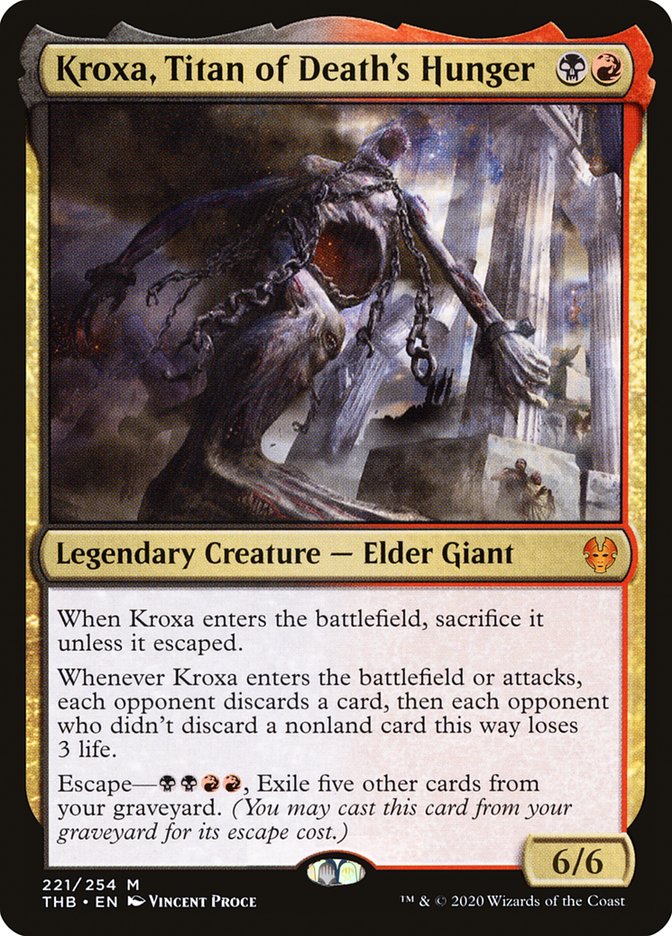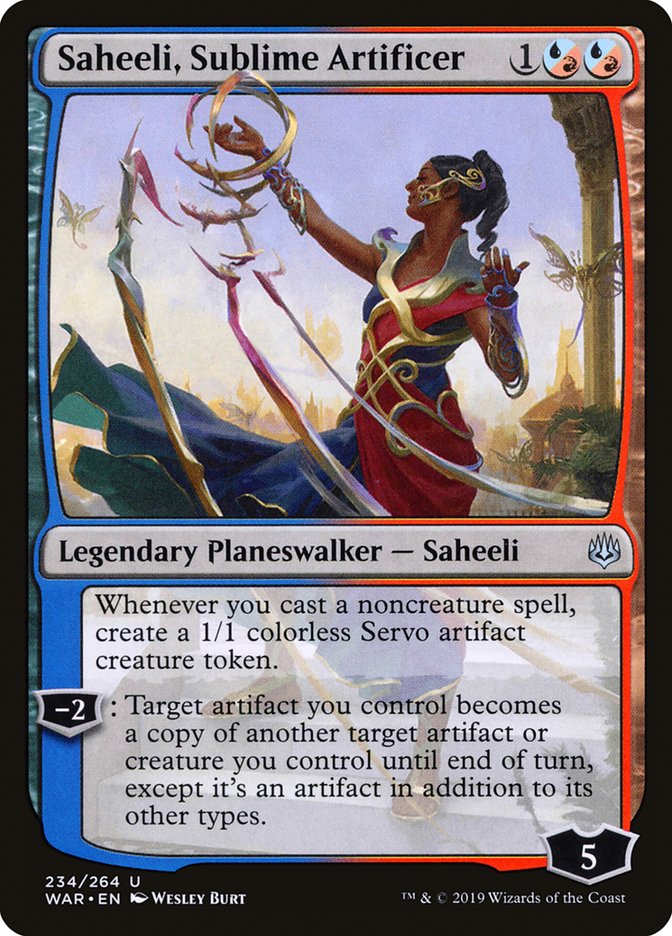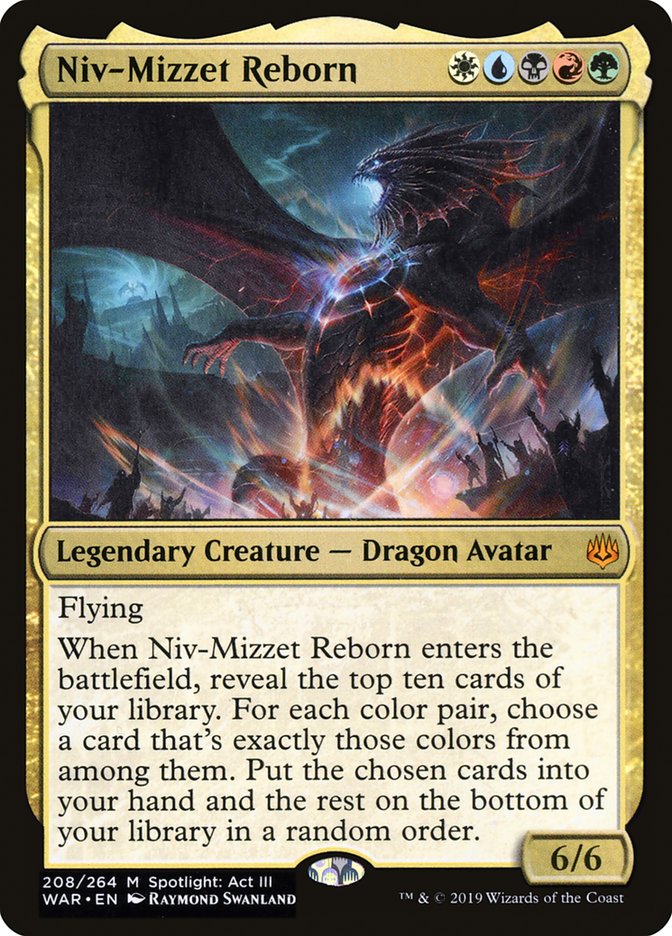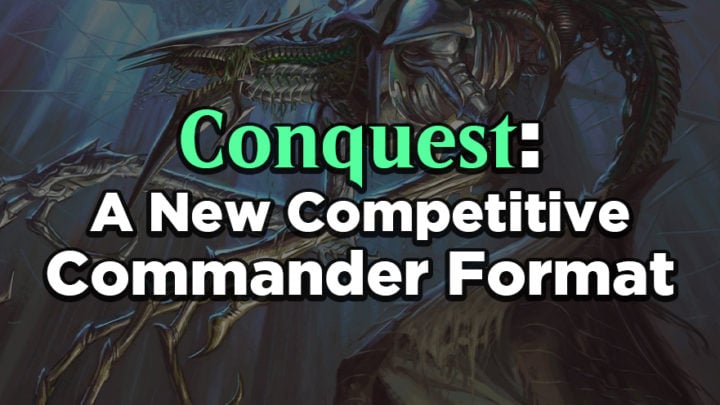Hello friends! I’ve got something a little different for you with this week’s article. We’re not discussing new cards, but a new format that’s gathered some momentum in the community — Conquest!
Like the Gladiator format presented by impresario Benjamin Wheeler last month, Conquest has evolved from the community’s love of large-deck singleton formats. These formats capture many fun aspects of Magic which are harder to find in Standard or Modern, and which make them well-suited to low-stakes multiplayer with friends. But “fun” means different things to different Magic players. When someone who just wants to cast as many different-colored dragons as possible runs into a player who wants to play a hyper-efficient combo like Flash + Protean Hulk, only one of those players is going to walk away satisfied — at best.
Conquest is a format created by players who love powerful, efficient Magic and finding ways to optimize their decks — but who still want to play with their friends! Superficially similar to Commander, its declared goal of cultivating balanced but high-powered gameplay cuts down on misgivings about power level and allows for balance decisions that prioritize the health of the format’s metagame. Even if you don’t consider yourself a cEDH player, you might be surprised how much you enjoy this re-balanced version!
To help me understand more, I reached out to the team of players and community leaders who have worked to develop Conquest. The group includes representatives from some of the largest cEDH communities and content creation teams; their leader Shaper invented the format, and admins the official Conquest Discord.
(Interview has been condensed and edited.)
How did the idea for Conquest come about? How did a community of players congregate around not just the idea of an alternative competitive Commander format, but this ruleset/banlist in particular?
Wedge (of West Coast Commander YT channel): Conquest has been a brainchild of Shaper’s for a number of years and in different forms. But, if I recall, the foundation has always been:
A) Removing the Reserved List, thus eliminating the biggest barrier to entry that plagues the eternal formats.
B) A focus on balanced multiplayer, specifically enabling strategies other than combo to be successful.
C) Bridging the gap between the other colors in multiplayer.
These main points are what really attracted us all to give this idea a shot and see where it could go. When balancing Conquest, we’ve tried to keep points B and C in mind at all times, and I think it really shows in the specific rules implemented thus far (Planeswalkers can be commanders, lower life totals, 12 commander damage, and an 80-card minimum).
Shaper: Our experience as a group in pushing Commander to its limits in cEDH has yielded a lot of insight into both what is enjoyable about high-velocity intensive multiplayer Magic and what elements detract from its stability as a strategy game. Ideas around what a balanced multiplayer experience might look like have been brewing for years.
What really catalyzed the formalization of Conquest was the period in cEDH in which Flash Hulk rose to dominance; it threatened the variety of our games and we felt compelled to find new ways to play multiplayer Magic. Since then, the Commander Rules Committee has heard that feedback from players and made the decision to ban Flash — it was a huge boon to cEDH as a whole and a lot of health has returned to the meta. Even after, Conquest remains compelling in its own right, so we have been continuing its development. Where cEDH might represent a Vintage power level, we find that Conquest represents something between Legacy and Modern power level, which opens up a lot of gameplay that’s unavailable in cEDH.

Why do you think people are drawn to play cEDH, despite the Commander rules intentionally exaggerating the variance of Magic and de-emphasizing competitive balance? Why not turn that drive towards Magic‘s other, explicitly competitive formats? What are the attractive qualities you’re trying to preserve in Conquest?
Shaper: There are a multitude of reasons people enjoy cEDH. Primarily, high-power Magic is explosive and fun. It captures a very satisfying blend of puzzles, math, algorithm building, sequencing, and deck construction. From the more casual side of Commander, playing with like-minded friends in a social setting is one of the best ways to play the game — we can see that in its unbounded popularity. cEDH represents a fusion of both of these ideals; it’s a mutually agreed upon cage match of styling on your friends with the most powerful Magic possible.
“Why not just play X constructed format?” is a common question levied at cEDH by people drawn to lower-power or less game-objective-focused groups. The simple answer is that cEDH players are in it for the multiplayer experience. It’s fun, extra complex, interactive, and social, and Commander flavor is unmatched across Magic. It’s a different way of enjoying the same game — some Magic players’ attraction to playing is optimization and testing their mettle, but they also want to achieve those goals in a social group setting.
Conquest seeks increase accessibility to the highest level of play by both widening the goalposts and making those decks affordable to a bigger audience. It also meaningfully removes gameplay-detracting cards and strategies from the pool of options, which improves the game experience for everyone involved.
The numeric tweaks that Conquest makes to the base Commander rule set seem very deliberate. What aspects of Commander (especially cEDH) have you tried to alter?
Pongo (of TeamTurnThree stream team): Reducing starting life totals (from 40 to 30) increases the viability of combat or damage/life loss strategies and decreases the abusability of life payment, such as with powerful cEDH staples (Necropotence, Ad Nauseam and Sylvan Library) and in mana production (Ancient Tomb and Mana Vault). Similarly, the reduced commander damage total (from 21 to 12) makes Voltron strategies more viable while also allowing players to more effectively pressure opponents playing combo-focused decks.
The decreased deck size (from 100 to 80) is intended to increase the consistency of decks/color combinations with less access to tutors. This also has the added effect of being able to see an individual card much more often, which helps build and tune coherent strategies. On that note, a number of tutors are banned to decrease the consistency of combo decks across the board while also providing some much-needed balance to the color pie in multiplayer.
Put simply, the banlist seeks to increase strategic diversity in multiplayer Magic by limiting the number of tools decks have access to to win consistently and quickly! But having our own banlist also allows us to bring some favorites back to the format which are banned in Commander. Ever wanted to play with Emrakul, Prime Time or Braids? Do you still lie awake at night thinking about your masterpiece Paradox Engine? You can use them all here!

In addition to cards banned based on power level, Conquest also has a blanket ban on any card from the Reserved List, as well as the ten dual-color fetchlands. Were there conflicted feelings over banning such a broad swathe of cards, many of which are useful or at least harmless in Commander? What is the motive behind it? Why specifically those fetchlands, and nothing else?
Shaper: The net effect on affordability and the power of gameplay of banning the Reserved List is ultimately worth losing odds-and-ends that might be within acceptable power bounds of the format. The blanket ban ensures that the accessibility factor we strive for is baked into the format, so as to prevent the need for accessibility bans at future points, which would not be ideal for a format that makes bans on balance.
Fetchlands present problems on three fronts: balance, accessibility, and physical paper play. In Commander (and, really, other competitive formats that include fetches), it is power-optimal to run as many fetchlands (with some deference to exception) that you can run; they offer some of the best color fixing possible and have many powerful synergies that other lands do not (graveyard fuel, shuffling, land-type-matters, triggering other permanents).
They also make it possible and easy to play four- or five-color strategies with little consistency loss, which skews power toward having more options in your color identity pool. This ultimately requires players to have access to as many of the fetches as possible, which (as of this writing) is a $420 barrier to entry. Banning fetches shifts the power level of the entire format in a good direction, while making the game more accessible, and removing the need to wait on end-step fetches. It’s been a win on every axis for the format.
Sigi (of LabManiacs.com): While it’s unfortunate to lose some of the cool cards on the Reserved List, its existence runs counter to our desire to make Conquest paper play affordable and accessible.
Fetchlands remove the usual deck-building cost that comes with gaining access to more colors. One thing we learned from cEDH is that having easy access to all colors is not a healthy thing when it comes to format balance. It makes it so one- and two-color Commanders have to come with disproportionately powerful effects to keep up with the much wider range of staple cards that four- or five-color decks have access to. Removing fetchlands also makes building mana bases much more interesting. While mana base deck-building choices in cEDH were limited to a handful of land slots at best, the mana bases in Conquest can look wildly different from deck to deck.

What’s the metagame like in Conquest? Are the clear “best decks” figured out yet among the community? What’s the gap in power between those leading decks and the average brew someone might build around their pet Commander?
Imoc (Mentor on r/competitiveEDH) The metagame for Conquest is still developing and the best decks have yet to solidify. With the way the banlist is set up and the intentional boost to deck variance, the gap in play potential between strong decks and average brews is generally lower than in cEDH. Combo decks are still powerful, but they have to pay better attention to aggro decks and decks that rely on commander damage. Pod composition plays a large role in how comfortable these faster decks end up feeling. It’s hard to say where every archetype/color falls in a tournament environment, as a deck’s success varies depending on the meta. Initial testing has shown that there are decks that can compete in your average Conquest pod across most color combos (including mono white or black, which is pretty unheard of in cEDH currently). While the format still favors combo, there are some pretty competitive decks that rely on combat damage and commander damage.
Shaper: Beyond the novelty of the format, it seems to me that our rule set has brought a pretty strong rock-paper-scissors of archetypes that helps the format elude a coalesced top tier. Multiplayer dynamics are also part of the equation, where clearly strong strategies have a much tougher time prospering when three players are looking to smash, and dark-horse strategies have time to grow their advantage while dodging the spotlight.
The gap in power between an established deck and an “average brew” is definitely closer in Conquest than it is in cEDH. In Conquest, if you have a coherent strategy and interact with the decks you face, you can appropriately dream big. Never forget that the established decks were brews at one point in time.
Does deck variety usually extend through the whole 80 cards, or do the same crop of mana accelerants, interaction and combo finisher cards show up every game under new commanders?
Sigi: While there are a few staples that make their way into most decks, the overall variety of played cards is quite high at the moment. Of course, we still have go-to staples when it comes to specific card packages, like mana dorks or counterspells, but the overall build variety is so high that you won’t encounter these packages in every game. To provide an example, we’ve seen a good number of games with one or even zero blue players.
When it comes to finishers, Conquest has a great deal of variety. Most of the efficient cEDH finishers are either banned or more difficult to work with in various ways. We found that this leads people to build decks that are more focused around their Commanders and the combo potential or synergies they might offer.

One of the largest complaints people make about Commander is the inherent weakness of aggro decks vs. the inherent strength of combo, and of one-for-one interaction vs. value engines. Do you see this as an issue for your format? What does Conquest do to offset this imbalance and make aggro competitively viable?
Imoc: Combo is still inherently powerful, but the bans and the reduction in life total and commander damage have opened the way for combat damage strategies to gain ground in the meta. I will say that interaction tends to be more powerful here than cEDH. The increased variance creates a greater tempo loss for players being interacted with. Board wipes and removal of key components are harder to recover from and present a greater loss for the player than they would in cEDH. Overall, our ban and design decisions have done a lot to reduce some of the inherent strengths of combos and value engines, but those strategies still remain viable and an important part of the format landscape.
Shaper: One of the important parts of addressing the “aggro weakness” problem comes from a shift of consciousness regarding combat’s speed in multiplayer, be it Conquest or Commander. “Aggro” as seen in 1v1 with 20 life is often the aggressor — it aims to kill the other player by rushing them down. It’s simply not possible in multiplayer to rush down all three players with tiny combat threats before they can stabilize. In this vein, combo is the “aggressor,” and wide combat only becomes a win condition when the game has reached a state where a player’s advantage is insurmountable. In Conquest, it’s much more important to understand your deck’s combat potential and build in that inevitability if reaching those board states is a central plan of yours, while respecting your vulnerability to combos in interaction choice.
I’d say that combat-oriented strategies (be it going wide, Voltron, or a control-finisher) are viable in Conquest in many ways that they aren’t in combo-wild Commander, but it requires a philosophy a bit divergent from what you’d call an “aggro strategy” in the traditional sense.
Both one-for-one and value-centric removal are important in Conquest in different ways. Instant speed one-for-one interaction is important to prevent losses to combo or snappy Voltron commanders, and value removal is important for slower decks to start gaining advantage on the other players. There’s room to adopt some different philosophies in this regard, and I’ve seen a variety of these pieces played with success.
What advantages does Conquest gain from making high-powered gameplay part of its identity? Is there any disagreement among the community about what an appropriate power level is for the format? Are any strategies still frowned upon — famous villains like land destruction, prison decks, heavy permission, infect or all-in combo?
Sigi: I think one advantage of Conquest is that there’s no stigma associated with the strategies many people consider un-fun in Commander. If something works, it’s cool. And you should try to be prepared for it.
Another advantage of this competitive identity is that there will be no perceived barrier that keeps people from playing multiplayer Magic to win. Multiplayer free-for-all games create some fascinating dynamics that no other type of game has to offer, but these dynamics tend to be obfuscated by the notion of explicitly casual play. In turn, we aim to bring them to the forefront of our players’ experiences.
I feel it’s difficult to go from the top down and say “this is the power level we want the format to be at.” While we did go into Conquest with the idea that most over-the-top things from cEDH would be banned and the power level would be lower as a result, our foremost goal is maximizing strategic diversity rather than a specific power level.

Conquest allows players to choose any Planeswalker as their commander with no drawback. What has been the impact of that? Do Planeswalkers end up being more or less powerful and popular than creature commanders, on average? Are play patterns too repetitive, as some in the Commander community fear? Is there sufficient interaction available in each color to combat them?
Sigi: We find that Planeswalkers tend to be as or less powerful on average than creature commanders. While there are some exceptions (mostly Planeswalkers with combo potential, or Planeswalkers that can leverage Reality Scramble), combat is a big part of this format thanks to reduced life totals and Commander damage being at 12. Every Planeswalker deck needs to have a plan for keeping its Commander alive when it could be attacked by three other players!
From what we’ve seen so far, this strategic facet is also one of the reasons why the play patterns with Planeswalker commanders haven’t been particularly repetitive. When it comes to interacting with Planeswalkers, most decks have been able to do so to a sufficient degree without having to resort to Planeswalker-specific removal cards.
What are some prominent decks/strategies in Conquest which are ported from cEDH or Canadian Highlander? What are some which can be ported from popular Constructed strategies in 60-card formats? Are there some which are largely unique to the Conquest format? Which decks are your personal favorite?
Sigi: Some of the unique strategies we’ve seen in Conquest include Skullclamp Storm with Nahiri, Storm of Stone and One-shot Greven. Decks like Rainbow Niv, Edric Turns, Urza and Tatyova are also being played.
Wedge: Many decks such as Edric, Gitrog, Heliod, Animar, Urza and Captain Sisay come to mind as ones that port over relatively easily from Commander. As for 60 card format ports, there are strategies like Reanimator, Cheat-in Emrakul, Elfball, High Tide, Eggs, UWx Control, Breach, Storm, Doomsday… even Hogaak Voltron is a thing!
My favorite decks to play are Greven and Sisay, and I’m currently exploring Daretti, Ingenious Iconoclast, which has been a blast.
Shaper: My personal pet projects (between brewing starter decks for new Conquest players to try) have been Rainbow Control Niv-Mizzet Reborn, Korvold Lands, Kroxa Discard Slug, and lately, Tinybones Gray Merchant Reanimator.

Apart from the official Discord, what communities or tools would you recommend to players entering the Conquest format? How easy is it to find a game on any given day? Does the community largely focus on tournaments, or pick up games?
Imoc: The deck hosting site Moxfield has been working with the Conquest team. There is full support for assessing Conquest legality of lists. They also support primers, have filters for the format, and a format page so people can easily view Conquest decks. With some foresight, games are relatively easy to arrange (the Discord runs a weekly game night), and we focus mostly on pickups. We have heard of some playgroups picking it up in paper, but most of our information comes from online play.
You can find a list of starter decks on our team’s Moxfield account.
Who is currently “in charge of” the Conquest format? What are their long-term goals for the growth of the format? How would you feel if WotC one day announced they would now support Conquest as a tournament format?
Shaper: The balance team consists of Sigi, Pongo, Wedge, Imoc, and myself. Our goals for the format are centered around the health and enjoyment of the game experience and community; we want to foster a gaming environment that puts fun, accessibility, mutual growth, open exploration, and sportsmanship at the core of the multiplayer Magic. Obviously, the idea behind Conquest is to make it possible to play to win, but we’re not looking to avoid the inherent social nature of multiplayer, nor shift it out of the playground of the playgroup and into a tournament setting.
Adoption of Conquest has come first at the playgroup level by groups that desire this kind of Magic experience. Other forms of organized play are on the horizon, with potential emerging to see Conquest played in some stores post-reopening and online in starting our own official league.
Sigi: We’d be happy to see official support, but I think it would have to come with a concrete plan for tournament organization. Multiplayer free-for-all games require a different event structure, and round times and player politics in particular might be a concern for organizers. The Conquest rules are an improvement over traditional Commander in that regard: there’s much less library searching without fetches and as many tutors, and the lower life and commander damage totals prevent game stalls.

How frequently are the rules and banlist of Conquest updated? Does the committee take a proactive approach to improving the format, or is the plan only to react when a clear issue is outstanding? Is there any motivation for Conquest to review and perhaps implement some of the suggested rules changes which are frequently bandied around in Commander communities?
Pongo: The current approach is somewhat similar to that of Pioneer when it was first announced: Conquest updates occur after issues or potential improvements are identified and solutions are thoroughly discussed. It is fair to say that the current approach is fairly proactive, and will continue to be so at least until we are satisfied with the basic parameters of the format and the established metagame. We aim to deploy our updates in tandem with the WotC and Commander update schedule (with some delay to process changes they’ve made), but in this burgeoning phase, we make updates to meet problems as they arise.
There is and will no doubt continue to be a lot of internal discussion surrounding many of the “suggested rules changes” (such as the color identity of hybrid mana or legality of flip-legends as Commanders). In many ways, our discussions mirror the ones in the Commander community at large (including the arguments for and against), but we are in no way beholden to the philosophies held by the Commander Rules Committee.
A good example of divergence is our usage of both “Banned as Commander” and “Banned as Companion” lists. While we acknowledge that these lists add a certain amount of rules overhead, our philosophy on this point diverges pretty significantly from that of the Commander RC (who removed their “Banned as Commander” list in 2015 and more recently banned Lutri, the Spellchaser from Commander completely rather than create a new “Banned as Companion” status).
Any final messages/advice/shoutouts you want to convey to potential new Conquest players reading this right now?
Pongo: Praise Lord Grob.
Wedge: Come play Conquest and hang out on our Discord! Weekly pickup event is Sunday at 3PM EST.

Tom’s fate was sealed in 7th grade when his friend lent him a pile of commons to play Magic. He quickly picked up Boros and Orzhov decks in Ravnica block and has remained a staunch white magician ever since. A fan of all Constructed formats, he enjoys studying the history of the tournament meta. He specializes in midrange decks, especially Death & Taxes and Martyr Proc. One day, he swears he will win an MCQ with Evershrike. Ask him how at @AWanderingBard, or watch him stream Magic at twitch.tv/TheWanderingBard.

